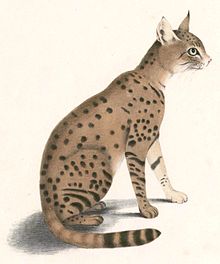Asiatic wildcat
| Asiatic wildcat | |
|---|---|
 |
|
| Scientific classification | |
| Kingdom: | Animalia |
| Phylum: | Chordata |
| Class: | Mammalia |
| Order: | Carnivora |
| Family: | Felidae |
| Genus: | Felis |
| Species: | F. silvestris |
| Subspecies: | F. s. ornata |
| Trinomial name | |
|
Felis silvestris ornata Gray, 1830–1832 |
|
The Asiatic wildcat (Felis silvestris ornata) is a wildcat subspecies that occurs from the eastern Caspian north to Kazakhstan, into western India, western China and southern Mongolia. It is also known as the Asian steppe wildcat and Indian desert cat. The status Least Concern in the IUCN Red List is attributed to the species, including all subspecies of wildcats. There is no information on current status or population numbers for the felid's entire range, but populations are thought to be declining.
The Asian wildcat has a long, tapering tail, always with a short black tip, and with spots at the base. The forehead has a pattern of four well-developed black bands. A small but pronounced tuft of hair up to one cm long grows from the tip of each ear. Paler forms of Asian wildcat live in drier areas and the darker, more heavily spotted and striped forms occur in more humid and wooded areas. The throat and ventral surfaces are whitish to light grey to cream, often with distinct white patches on the throat, chest and belly. Throughout its range the Asian wildcat’s coat is usually short, but the length of the fur can vary depending on the age of the animal and the season of the year. Compared to the domestic cat, Asian wildcats have relatively longer legs. Males are generally heavier than females.
In Pakistan and India, wildcats have pale sandy yellow coats, marked with small spots that tend to lie in vertical lines down the trunk and flanks. The wildcats of Central Asia have a more greyish-yellow or reddish background color, marked distinctly with small black or red-brown spots. The spots are sometimes fused into stripes, especially in the Central Asian regions east of the Tian Shan Mountains.
They weigh about 3 to 4 kg (6.6 to 8.8 lb).
The Caucasus is the transitional zone between the European wildcat to the north and west, and the Asiatic wildcat to the south and east. In this region, European wildcat is present in montane forest, and Asiatic wildcat is present in the low-lying desert and semi-desert areas adjoining the Caspian sea. It usually occurs in close proximity to water sources, but is also able to live year-round in waterless desert. It ranges up to 2,000 to 3,000 m (6,600 to 9,800 ft) in mountain areas with sufficient dense vegetation. Snow depth limits the northern boundaries of its range in winter.
...
Wikipedia
